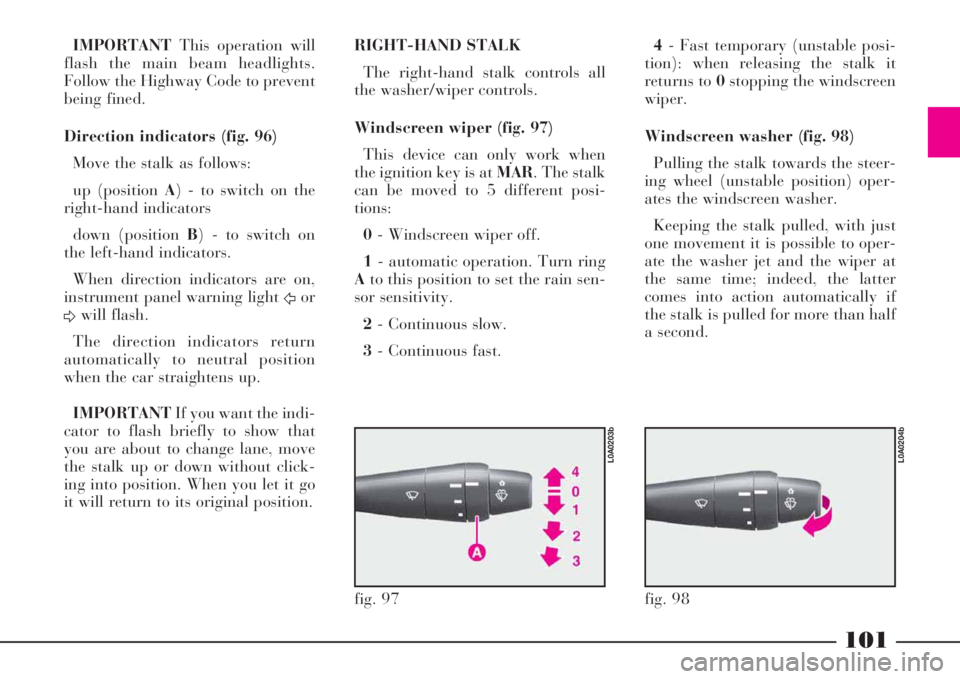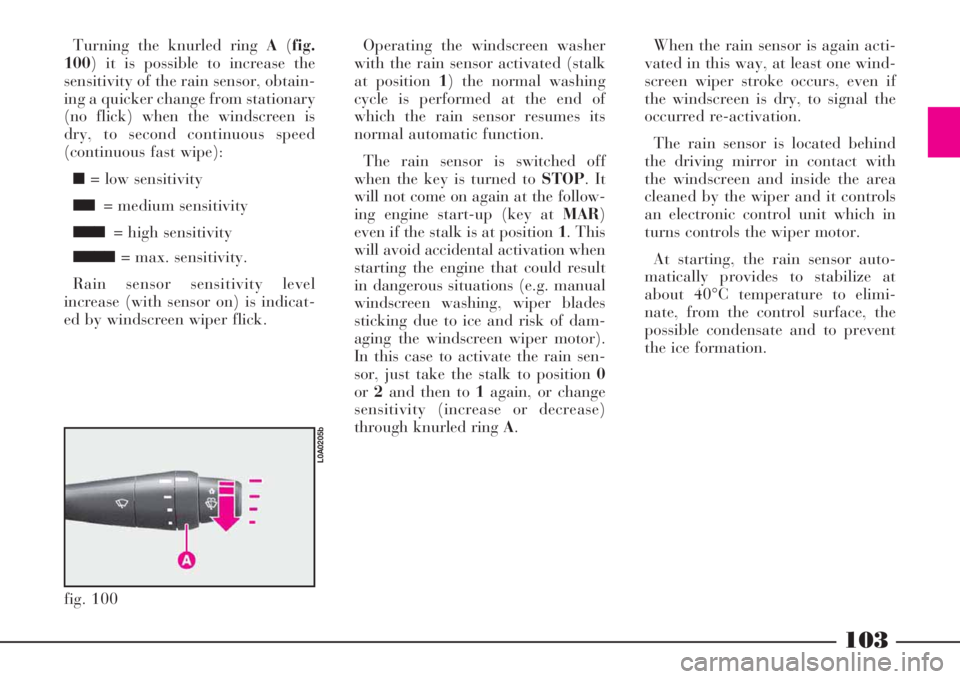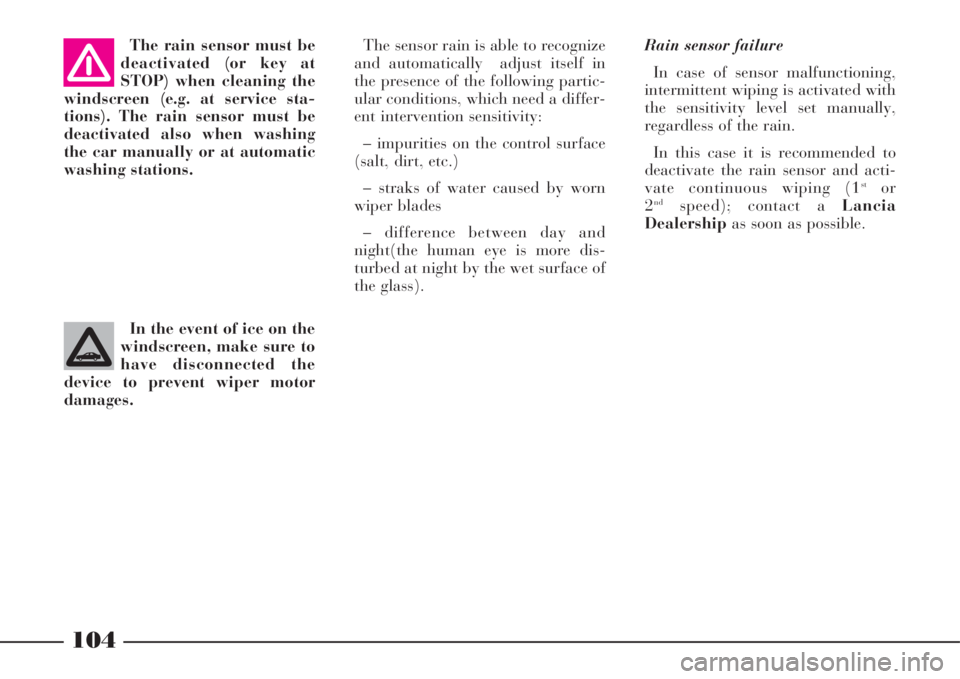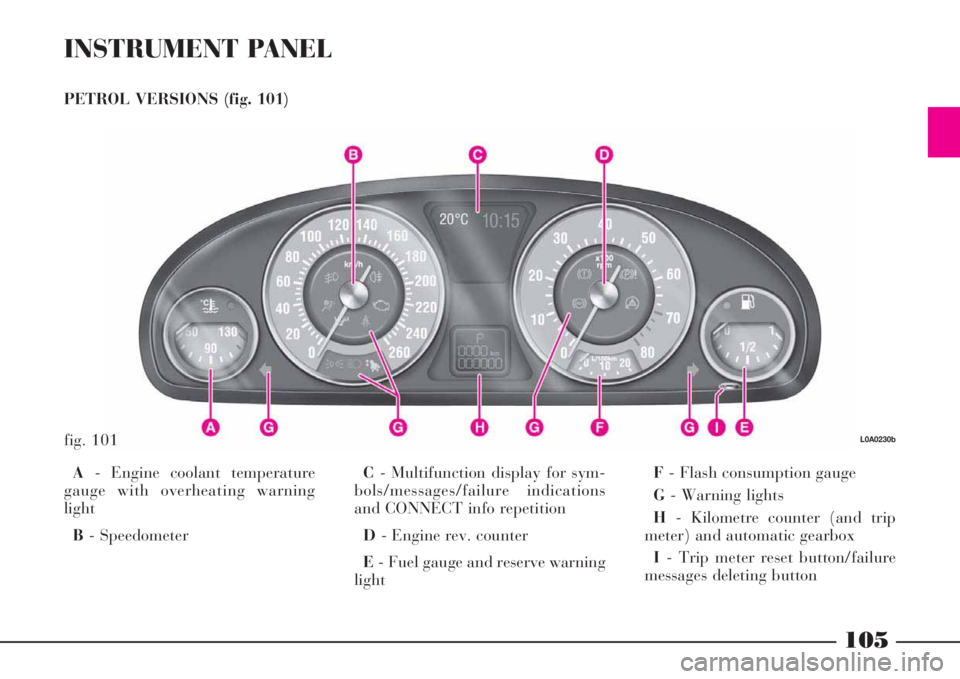Lancia Thesis 2008 Owner handbook (in English)
Manufacturer: LANCIA, Model Year: 2008, Model line: Thesis, Model: Lancia Thesis 2008Pages: 386, PDF Size: 4.96 MB
Page 101 of 386

100
After activating the device, the set
time can be extended also within 2
minutes from when the engine is
turned off by pulling the stalk.
Keeping the stalk pulled for over 2
seconds will deactivate this function
with immediate light turning off as a
consequence.
To flash the lights (fig. 95)
Pull the stalk towards the steering
wheel (position B). Instrument panel
warning light 1will come on. LEFT-HAND STALK
The left-hand stalk controls the
external lights and the direction
indicators.
Main beam headlights (fig. 95)
These lights come on pushing the
left-hand stalk forwards (position
A), with dipped beam headlights
switched on both manually (ring to
2) and automatically (ring to
AUTO).
When these lights are on, the
instrument panel warning light 1
is on.
To switch the main beam head-
lights off, pull the stalk back
towards the steering wheel.If main beam headlights
are on (left stalk for-
wards), they will turn on
automatically each time the twi-
light sensor makes the outside
lights switch on automatically. It
is therefore recommended to turn
off the main beam headlights (if
on), moving backwards the left
stalk, each time the sensor
switches off the outside lights.
fig. 95
L0A0206b
fig. 96
L0A0207b
Page 102 of 386

101
IMPORTANTThis operation will
flash the main beam headlights.
Follow the Highway Code to prevent
being fined.
Direction indicators (fig. 96)
Move the stalk as follows:
up (position A) - to switch on the
right-hand indicators
down (position B) - to switch on
the left-hand indicators.
When direction indicators are on,
instrument panel warning light
Ÿor
Δwill flash.
The direction indicators return
automatically to neutral position
when the car straightens up.
IMPORTANTIf you want the indi-
cator to flash briefly to show that
you are about to change lane, move
the stalk up or down without click-
ing into position. When you let it go
it will return to its original position.RIGHT-HAND STALK
The right-hand stalk controls all
the washer/wiper controls.
Windscreen wiper (fig. 97)
This device can only work when
the ignition key is at MAR. The stalk
can be moved to 5 different posi-
tions:
0- Windscreen wiper off.
1- automatic operation. Turn ring
Ato this position to set the rain sen-
sor sensitivity.
2- Continuous slow.
3- Continuous fast.4- Fast temporary (unstable posi-
tion): when releasing the stalk it
returns to 0stopping the windscreen
wiper.
Windscreen washer (fig. 98)
Pulling the stalk towards the steer-
ing wheel (unstable position) oper-
ates the windscreen washer.
Keeping the stalk pulled, with just
one movement it is possible to oper-
ate the washer jet and the wiper at
the same time; indeed, the latter
comes into action automatically if
the stalk is pulled for more than half
a second.
fig. 97
L0A0203b
fig. 98
L0A0204b
Page 103 of 386

102
The wiper stops working a few
strokes after releasing the stalk; a
further “cleaning stroke”, after a
few seconds completes the wiping
operation.
Windscreen washer nozzles are fit-
ted with demisting resistors that cut
in automatically (for about 3 min-
utes) when pressing the fast window
demisting/defrosting button.
Headlight washer (fig. 99)
Pulling the stalk towards the steer-
ing wheel will also operate the head-
light washers providing that the
dipped beam headlights are on.IMPORTANTUnder certain con-
ditions, when headlight washers are
on, the climate control system acti-
vates automatically the inside air
recirculation to prevent washer fluid
smell inlet into the passenger’s com-
partment.
Rain sensor
The rain sensor is an infrared led
sensor installed on the windscreen
and combined with the windscreen
wiper which automatically suits the
flick frequency during operation to
the intensity of rain.
All the functions controlled with
the right-hand stalk (i.e. on/off,
continuous slow and fast wipe, tem-
porary fast wipe, windscreen washer
and headlight washer) are unvaried.
fig. 99
L0A0122b
The rain sensor is automatically
switched on when the stalk is taken
to position 1(fig. 97) and has the
purpose of adjusting the range of
operation from stationary (no flick)
when the windscreen is dry to sec-
ond continuous speed (continuous
fast wipe) when the rain is heavy.
When taking the stalk to 1to acti-
vate the rain sensor, the windscreen
wiper indicates the sensor activation
by a flick.
IMPORTANTTo guarantee prop-
er rain sensor operation, keep the
glass clean in the sensor area.
Page 104 of 386

103
Operating the windscreen washer
with the rain sensor activated (stalk
at position 1) the normal washing
cycle is performed at the end of
which the rain sensor resumes its
normal automatic function.
The rain sensor is switched off
when the key is turned to STOP. It
will not come on again at the follow-
ing engine start-up (key at MAR)
even if the stalk is at position 1. This
will avoid accidental activation when
starting the engine that could result
in dangerous situations (e.g. manual
windscreen washing, wiper blades
sticking due to ice and risk of dam-
aging the windscreen wiper motor).
In this case to activate the rain sen-
sor, just take the stalk to position 0
or2and then to 1again, or change
sensitivity (increase or decrease)
through knurled ring A.When the rain sensor is again acti-
vated in this way, at least one wind-
screen wiper stroke occurs, even if
the windscreen is dry, to signal the
occurred re-activation.
The rain sensor is located behind
the driving mirror in contact with
the windscreen and inside the area
cleaned by the wiper and it controls
an electronic control unit which in
turns controls the wiper motor.
At starting, the rain sensor auto-
matically provides to stabilize at
about 40°C temperature to elimi-
nate, from the control surface, the
possible condensate and to prevent
the ice formation. Turning the knurled ring A(fig.
100) it is possible to increase the
sensitivity of the rain sensor, obtain-
ing a quicker change from stationary
(no flick) when the windscreen is
dry, to second continuous speed
(continuous fast wipe):
■= low sensitivity
■■= medium sensitivity
■■■= high sensitivity
■■■■= max. sensitivity.
Rain sensor sensitivity level
increase (with sensor on) is indicat-
ed by windscreen wiper flick.
fig. 100
L0A0205b
Page 105 of 386

104
Rain sensor failure
In case of sensor malfunctioning,
intermittent wiping is activated with
the sensitivity level set manually,
regardless of the rain.
In this case it is recommended to
deactivate the rain sensor and acti-
vate continuous wiping (1
stor
2ndspeed); contact a Lancia
Dealershipas soon as possible. The rain sensor must be
deactivated (or key at
STOP) when cleaning the
windscreen (e.g. at service sta-
tions). The rain sensor must be
deactivated also when washing
the car manually or at automatic
washing stations.
The sensor rain is able to recognize
and automatically adjust itself in
the presence of the following partic-
ular conditions, which need a differ-
ent intervention sensitivity:
– impurities on the control surface
(salt, dirt, etc.)
– straks of water caused by worn
wiper blades
– difference between day and
night(the human eye is more dis-
turbed at night by the wet surface of
the glass).
In the event of ice on the
windscreen, make sure to
have disconnected the
device to prevent wiper motor
damages.
Page 106 of 386

INSTRUMENT PANEL
PETROL VERSIONS (fig. 101)
A- Engine coolant temperature
gauge with overheating warning
light
B- SpeedometerC- Multifunction display for sym-
bols/messages/failure indications
and CONNECT info repetition
D- Engine rev. counter
E- Fuel gauge and reserve warning
lightF- Flash consumption gauge
G- Warning lights
H- Kilometre counter (and trip
meter) and automatic gearbox
I- Trip meter reset button/failure
messages deleting button
fig. 101L0A0230b
105
Page 107 of 386

106
JTD VERSIONS (fig. 102)
fig. 102L0A0231b
A- Engine coolant temperature
gauge with overheating warning
light
B- SpeedometerC- Multifunction display for sym-
bols/messages/failure indications
and CONNECT info repetition
D- Engine rev. counter
E- Fuel gauge and reserve warning
lightF- Flash consumption gauge
G- Warning lights
H- Kilometre counter (and trip
meter) and automatic gearbox
I- Trip meter reset button/failure
messages deleting button
Page 108 of 386

107
INSTRUMENTS
SPEEDOMETER (fig. 103)
The speedometer shows the car
speed expressed in kilometres per
hour (km/h) and starts signalling
the speed when the car speed
exceeds approx. 4 km/h (see the
indications given in paragraph “At
the filling station").REV COUNTER (fig. 104)
If the needle is in the hazard sector
(the section with red lines) it shows
that the engine is over-revving. Do
not travel with the needle in this sec-
tor.
When the engine is idling, the rev
counter may show a gradual or sud-
den increase in engine speed,
according to the case. This is normal
and indicates the operation of the
climate control compressor or fans,
etc. In particular, a gradual varia-
tion in engine revolution speed safe-
guards battery charge.IMPORTANTThe hazard sectors
can present different widths and dif-
ferent full scale values according to
the various car versions.
IMPORTANTThe electronic injec-
tion control system will progressive-
ly cut off the flow of fuel when the
engine is over-revving and the
engine will consequently lose power.
fig. 103
L0A0232b
fig. 104
L0A0233b
Page 109 of 386

108
fig. 106
L0A0236b
ENGINE COOLANT TEMPERA-
TURE GAUGE WITH OVER-
HEATING WARNING LIGHT
(fig. 105)
This instrument indicates the
engine coolant temperature. It starts
signalling the temperature when this
reaches approximately 50 °C.
The needle should usually be on
middle scale values. reduce your
demand on the engine if the needle
approaches top scale values.The warning light Awill come on
together with message “ENGINE
COOLANT TEMPERATURE
HIGH” on the instrument panel dis-
play to indicate that the coolant
temperature is too hot. In this case,
stop the engine immediately and
contact a Lancia Dealership.
IMPORTANTThe needle may
approach the top scale values if the
engine cooling radiator external part
is obstructed or dirty. In this case,
inspect and remove the obstructions.
Accurately clean the external part of
the radiator as soon as possible.FUEL GAUGE AND RESERVE
WARNING LIGHT (fig. 106)
The fuel reserve warning light A
will come on together with message
“REFUEL” on the instrument panel
display to indicate that there are
approximately 10 litres of fuel in the
tank.
IMPORTANTDo not travel with
the fuel tank almost empty: the gaps
in fuel delivery could damage the
catalyst.
fig. 105
L0A0235b
Page 110 of 386

109
IMPORTANTRefuelling shall
always be performed with engine off
and ignition key to STOP. If the
engine is off but the key is to MAR,
a wrong fuel level could temporarily
be indicated. This is due to the inter-
nal system control logic and cannot
be considered as a system malfunc-
tioning.FLASH CONSUMPTION GAUGE
(fig. 107)
GaugeAshows the flash consump-
tion: to prevent excessively variable
values the gauge shows the average
consumption of the last minutes of
travel expressed in l/100 km (litres
per 100 km).
This is helpful for the driver for
learning the fuel consumption in
relation to the driving style.The gauge needle has the following
position:
– value 0 l/100 km with car sta-
tionary
– near value 2 l/100 km when the
car speed is between 4 and 20 km/h
and when releasing the accelerator
pedal during driving
– actual consumption value
(between 2 and 20 l/100 km) for
speeds exceeding 20 km/h.
fig. 107
L0A0234b